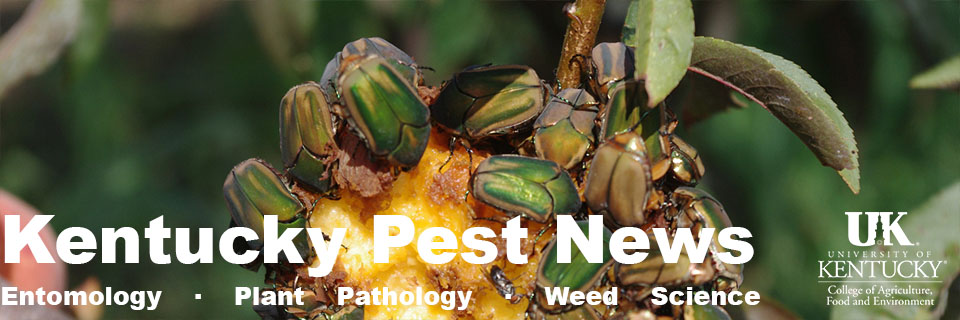Problem The soybean gall midge, Resseliella maxima (Diptera: Cecidomyiidae), is a relatively new pest in soybean. Although some findings have been reported since 2011 (CropWatch), large populations were noticed in plants located at the edges of soybean fields by late…
Monthly Archives: May 2021
Rhizosphaera Needle Cast May Lead to Skimpy Spruce
Rhizosphaera needle cast is often to blame for brown or thin spruce in the landscape. In Kentucky, Rhizosphaera needle cast is the most common disease of spruce; it also affects some pine species. This disease causes needle drop on lower…
Gummy Stem Blight & Black Rot of Cucurbits (PPFS-VG-08)
Gummy stem blight is an important disease of cucurbits in many parts of Kentucky. Under conditions favorable to disease development, commercial growers and home gardeners may experience heavy losses. Gummy stem blight is the name given to the disease when…
2021 Insect Trap Counts
Trap counts for major insect pests are provided by the Kentucky IPM Program. Traps are located at the UK Research and Education Center in western Kentucky and the UK Spindletop Farm in Lexington. Below are trap counts for the current…
Seedcorn Maggot Seen in Abundant Numbers in Corn and Soybeans
Seedcorn maggots (Figure 1) in corn and soybeans are typically observed during cool and damp seasons and in sites with organic rich soils (manure can be a source of this), including fields with reduced tillage or decaying residue from the…
Meso-Tunnels and Cucurbit Production
If you’re a vegetable grower, you’re probably familiar with high tunnels and low tunnels. But what are meso-tunnels? Each of these tunnel types are used to create a protective barrier between crops and the environment. “Meso” means “middle,” so meso-tunnels…
Laurel Wilt Disease: A Threat to Kentucky Sassafras Trees
Laurel wilt is a new disease that was recently detected in southwestern Kentucky. This disease, which is transmitted by the redbay ambrosia beetle, has the potential to rapidly kill sassafras trees. Currently no management options are available for this disease.…
EPA IPM Webinar: Mosquito Trapping – Right Trap, Right Place
Today (May 18), the Environmental Protection Agency (EPA) is hosting a webinar for credit on mosquito trapping. Vector control for mosquitoes involves strategies for trapping, monitoring, identifying and sorting the mosquitoes. This free webinar will emphasize the importance of matching…
EPA Extends Respiratory Protection Flexibility for Pesticide Handlers due to Covid-19
Earlier this month the EPA OPP extended the ‘Annual Fit Test’ option delay until September 30, 2021. This is due to limited availability of required respiratory protection and respirator fit testing. These options are not a waiver of regulations or…
Edema (PPFS-GEN-18)
Edema (or oedema) is a nonparasitic disorder that, under the right environmental conditions, can affect a wide variety of herbaceous plants. This problem is most frequently observed in greenhouses on ornamentals and vegetable transplants, but it may also occur on…
2021 Insect Trap Counts
Trap counts for major insect pests are provided by the Kentucky IPM Program. Traps are located at the UK Research and Education Center in western Kentucky and the UK Spindletop Farm in Lexington. Below are trap counts for the current…
Cool Weather and Cutworms
There have been reports of cutworm activity in field crops this spring. Cutworms (Figure 1), combined with slow plant growth due to cool weather, have the potential to result in increased damage to seedlings in some fields. Corn and soybean…
Predicting Future Cucurbit Crop Disease Risk Using Disease History
Past disease presence can indicate a risk for the same disease this year. Many pathogens overwinter on infected plant material or as pathogen survival structures. Poor sanitation practices can lead to an increased risk of these diseases in the upcoming…
Anthracnose Diseases on Shade Trees
The term anthracnose refers to the dark blotching (necrotic) symptom common to these diseases. When expanding leaves are affected, leaf distortion frequently results (Figure 1). Defoliation (leaf drop) often occurs during severe infections. The disease is generally not fatal, and…
Greenhouse Sanitation (PPFS-GH-04)
Diseases are a major concern for greenhouse growers and can be a key limitation to profitable plant production. Often, growers presume that fungicides are the most important disease management tool at their disposal. However, sanitation is extremely important in helping…
